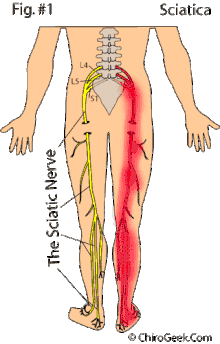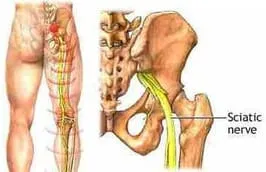SCIATICA
Sciatica is the term used for inflammation of the Sciatic nerve. Sciatica occurs
when there is pressure or damage to the sciatic nerve. This

Sciatica can start from a Slipped or Herniated disc, a tight Pyriformis muscle, injury to the gluteal musculature, Pelvic involvement etc.

The pain most often occurs on one side. Some people have sharp pain in one part of the leg or hip and numbness in other parts. The pain or numbness may also be felt on the back of the calf or on the sole of the foot. The affected leg may feel weak.
The pain often starts slowly. Sciatica pain may get worse:
-
After standing or sitting
-
At night
-
When sneezing, coughing, or laughing
-
When bending backwards or walking more than a few yards.

especially if caused by spinal stenosis. While sciatica is most commonly a result of a lumbar disc herniation directly pressing on the nerve, any cause of irritation or inflammation of the sciatic nerve can reproduce the symptoms of sciatica. This irritation of nerves as a result of an abnormal intervertebral disc is referred to as radicular pain, or radiculopathy. Aside from a pinched nerve, disc, other causes of sciatica include: irritation of the nerve from adjacent bone, tumors, muscle,internal bleeding, infections, injury, and other causes. Sometimes sciatica can occur because of irritation of the

Chiopractic treatment enables the body's potential to heal itself.. Chiropractic is based on the principle that restricted spinal movement leads to nerve root irritation and a decrese in normal function. Chiropractic treatments are hands on, non surgical and drug free..
The type of Chiropractic treatment provided depends on the cause of the sciatica. Sciatica treatment include: Ice or Cryotherapy, Ultrasound, TENS, and SpinalAdjustments/ Manipulations. .
- ICE reduces inflammation and helps to control sciatic pain.
- ULTRASOUND is sound waves that penetrates deep into the effected areas such as the muscles, ligaments, and tendons. Ultrasound increases circulation and helps to reduce muscle spasms, cramping, swelling, stiffness, and pain.
- TENS (Transcutaneous Electrical Nerve Stimulation ) or low volt current provides gentle msucle stimulation, reducing pain,swelling,and stiffness on the areas it is applied to.
Chiropractic Adjustment The Chiropractor will free up the areas of restricted spinal movement causing the pain and

Effective treatment for Sciatica is a combination of the modalities listed above, rest, stretching, etc. Patients usually respond well to treatments when the condition is addressed in the early stages, the longer a patient waits to seek treatment more inflammation builds up around the injured area decresing the responsiveness to treatment During care, the patient is instructed to avoid sports and exercise, ice to reduce inflammation. Patients are treated 2-3 times per week initially. Once progress is made the patient is seen less often, instructed to stretch at home. and gradually return to pre-accident activities. Most times Sciatica is an isolated incident and may , not reoccur. However, direct trauma to the area caused by work, sports, or motor vehicle injuries can cause Sciatica to reoccur. Those patients who have experienced Sciatica will seek Chiropractic treatments right away.